
The Internet's Premier Classical Music Source
Related Links
- Latest Reviews
- More Reviews
-
By Composer
-
Collections
DVD & Blu-ray
Books
Concert Reviews
Articles/Interviews
Software
Audio
Search Amazon
Recommended Links
Site News
 CD Review
CD Review
Kôsçak Yamada

Orchestral Music
- Overture in D Major *
- Symphony in F Major "Triumph and Peace"
- The Dark Gate
- Madara No Hana
Ulster Orchestra/Takuo Yuasa
* New Zealand Symphony Orchestra/Takuo Yuasa
Naxos 8.555350 DDD 58:21
Apart from Takemitsu, and maybe Mayuzumi (specifically for his "Nirvana" Symphony), most Westerners have had little exposure to Japanese classical music, so Naxos' inexpensive series of CDs devoted to this genre really fills a niche. Kôsçak Yamada (1886-1965), son of a samurai, was born during a time in which Western classical music, after having been kept at a distance during Japan's long feudal period, was beginning to be studied and played by Japanese musicians. Upon the death of his parents, Yamada went to Berlin in 1910 to study in the Musikhochschule under teachers who included Max Bruch. The four pieces on this CD were written in 1912-13, while Yamada continued his studies in Berlin.
The Overture in D (which is receiving its first recording here) is identified by annotator Morihide Katayama as the very first piece of Japanese orchestral music. By the same token, the Symphony in F is the first Japanese symphony. These two works, particularly the Symphony, are almost completely Western in style. (Yamada does include part of the Japanese national anthem Kimigayo in the first movement.) Yamada seems to have learned his Schubert and Schumann well, because the Symphony repeatedly reminds me of those composers' works. Overall, the music, while traditional, is bold and assertive, full of confidence over Japan's new international role. If the structure of these two early works is redolent of the textbook, it should be no surprise, because during this period, Yamada was studying with the conservative Professor Wolf at the Musikhochschule.
Once free of Wolf's tutelage, Yamada wrote in a freer, more chromatic style. The tone poems The Dark Gate and Madara No Hana, composed just one year after the first two works on this CD, differ from them like night and day. Here, the influence of the late Romantics and the Impressionists can be heard. I also found these tone poems to be unexpectedly Delian. The Dark Gate is based on a subject by Maeterlinck. Blindness, abandonment, and mortality are the main themes. Similarly, Madara No Hana is associated with death – the title refers to the literally heavenly flowers described in sacred Buddhist texts. In these works, Yamada also seems to be influenced by the overheated chromatic writing of Scriabin.
Yamada is a very interesting find, and his music will come as a complete surprise to those who expect Japanese music to adhere to Asian cultural stereotypes. These are first-class performances, technically strong and musically sensitive, and excellently recorded to boot. (In the Overture, the orchestra is the New Zealand Symphony Orchestra. Elsewhere, it is the Ulster Orchestra.)
Copyright © 2004, Raymond Tuttle


















